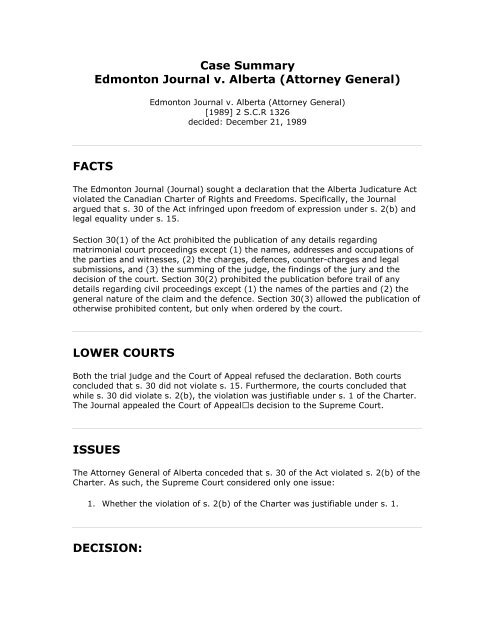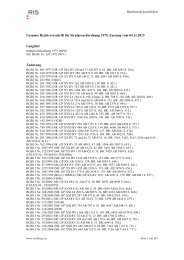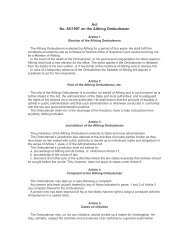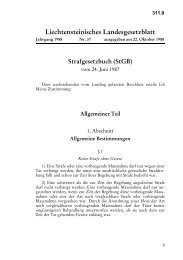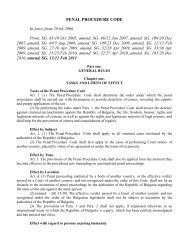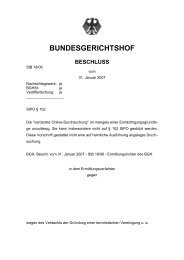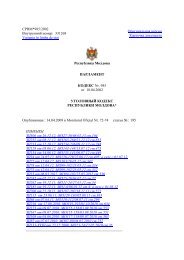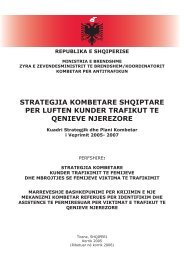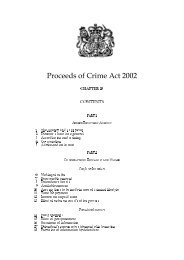Case of Edmonton Journal v. Alberta (Attorney ... - Legislationline
Case of Edmonton Journal v. Alberta (Attorney ... - Legislationline
Case of Edmonton Journal v. Alberta (Attorney ... - Legislationline
You also want an ePaper? Increase the reach of your titles
YUMPU automatically turns print PDFs into web optimized ePapers that Google loves.
<strong>Case</strong> Summary<br />
<strong>Edmonton</strong> <strong>Journal</strong> v. <strong>Alberta</strong> (<strong>Attorney</strong> General)<br />
FACTS<br />
<strong>Edmonton</strong> <strong>Journal</strong> v. <strong>Alberta</strong> (<strong>Attorney</strong> General)<br />
[1989] 2 S.C.R 1326<br />
decided: December 21, 1989<br />
The <strong>Edmonton</strong> <strong>Journal</strong> (<strong>Journal</strong>) sought a declaration that the <strong>Alberta</strong> Judicature Act<br />
violated the Canadian Charter <strong>of</strong> Rights and Freedoms. Specifically, the <strong>Journal</strong><br />
argued that s. 30 <strong>of</strong> the Act infringed upon freedom <strong>of</strong> expression under s. 2(b) and<br />
legal equality under s. 15.<br />
Section 30(1) <strong>of</strong> the Act prohibited the publication <strong>of</strong> any details regarding<br />
matrimonial court proceedings except (1) the names, addresses and occupations <strong>of</strong><br />
the parties and witnesses, (2) the charges, defences, counter-charges and legal<br />
submissions, and (3) the summing <strong>of</strong> the judge, the findings <strong>of</strong> the jury and the<br />
decision <strong>of</strong> the court. Section 30(2) prohibited the publication before trail <strong>of</strong> any<br />
details regarding civil proceedings except (1) the names <strong>of</strong> the parties and (2) the<br />
general nature <strong>of</strong> the claim and the defence. Section 30(3) allowed the publication <strong>of</strong><br />
otherwise prohibited content, but only when ordered by the court.<br />
LOWER COURTS<br />
Both the trial judge and the Court <strong>of</strong> Appeal refused the declaration. Both courts<br />
concluded that s. 30 did not violate s. 15. Furthermore, the courts concluded that<br />
while s. 30 did violate s. 2(b), the violation was justifiable under s. 1 <strong>of</strong> the Charter.<br />
The <strong>Journal</strong> appealed the Court <strong>of</strong> Appeal s decision to the Supreme Court.<br />
ISSUES<br />
The <strong>Attorney</strong> General <strong>of</strong> <strong>Alberta</strong> conceded that s. 30 <strong>of</strong> the Act violated s. 2(b) <strong>of</strong> the<br />
Charter. As such, the Supreme Court considered only one issue:<br />
1. Whether the violation <strong>of</strong> s. 2(b) <strong>of</strong> the Charter was justifiable under s. 1.<br />
DECISION:
The Supreme Court ruled that the <strong>Journal</strong> s appeal should be allowed (La Forest,<br />
L Heureux-Dube and Sopinka dissenting in part.) While a majority existed in the<br />
result, none existed in regards to reasons.<br />
Cory (writing for himself, Dickson and Lamer) concluded the following:<br />
1. The violation <strong>of</strong> s. 2(b) was not justifiable under s. 1 <strong>of</strong> the Charter.<br />
Wilson agreed with Cory s results but for different reasons.<br />
La Forest (writing for himself, L Heureux-Dube and Sopinka) dissented in part. He<br />
concluded the following:<br />
1. Section 30(2) was not justifiable under s. 1 <strong>of</strong> the Charter.<br />
2. However, the rest <strong>of</strong> s. 30 was justifiable under s.1 <strong>of</strong> the Charter.<br />
DECISION REASONS:<br />
Cory (with Dickson, Lamer)<br />
Section 1<br />
Cory concluded that s. 30 <strong>of</strong> the Act was not justifiable under s. 1 <strong>of</strong> the Charter.<br />
While the objective <strong>of</strong> the legislature was <strong>of</strong> sufficient importance, it nevertheless<br />
failed the proportionality test.<br />
Importance <strong>of</strong> the objective<br />
The objective <strong>of</strong> s. 30 differed in regards to it various subsections. The <strong>Attorney</strong><br />
General <strong>of</strong> <strong>Alberta</strong> put forward three objectives for s. 30(1). They included: (1) to<br />
safeguard <strong>of</strong> public morals, (2) to ensure that access to the courts for those who<br />
might wish to litigate matrimonial manners, and (3) to protect the privacy <strong>of</strong> those<br />
litigating. In regards to the first objective, the <strong>Attorney</strong> General argued that the<br />
publication <strong>of</strong> allegations <strong>of</strong> adultery and matrimonial misconduct threatened public<br />
morals. However, for Cory, while this may have been an issue when the legislation<br />
was enacted in 1935, this was no longer an issue in contemporary society. In<br />
regards to the second objective, the <strong>Attorney</strong> General argued that if individuals had<br />
the knowledge that their litigation would be publicly known, they may not seek their<br />
rights in court. However, for Cory, this argument was suspect. Current statistical<br />
data had shown that, even in jurisdictions where the press had free access to<br />
litigation, more and more individuals where seeking their rights in court and were not<br />
being deterred by the publicity. In regards to the third objective, however, Cory<br />
agreed that it was <strong>of</strong> sufficient importance. The right to privacy is an important value<br />
in society that should be protected, even in cases where it infringes upon Charter<br />
rights.<br />
The <strong>Attorney</strong> General put forward two objectives for s. 30(2). They included: (1) to<br />
ensure the right to a fair trial and (2) to protect reputations and privacy. As above,<br />
Cory found that the protection <strong>of</strong> privacy was <strong>of</strong> sufficient importance to infringe<br />
upon Charter rights.
Hence, because protection <strong>of</strong> privacy was a sufficiently important objective <strong>of</strong> s. 30,<br />
Cory concluded that s. 30 passed the first part <strong>of</strong> the s. 1 analysis.<br />
Proportionality test<br />
However, Cory concluded that s. 30 failed the second part <strong>of</strong> the s. 1 analysis: the<br />
proportionality test. First, s. 30 does not represent a minimal impairment <strong>of</strong> the<br />
freedom <strong>of</strong> expression. The section prohibits the publication <strong>of</strong> a wide range <strong>of</strong><br />
content in regards to court proceedings. Furthermore, the right to report freely on<br />
trial proceedings is an important right in society. For Cory, a free and democratic<br />
society necessitates a court system that is open to the public through the press.<br />
Finally, other measures that had a lesser effect upon freedom <strong>of</strong> expression could<br />
have been taken. For example, the prohibition <strong>of</strong> publication on a case-by case basis,<br />
not in every case as demanded by s. 30.<br />
Second, for Cory, s. 30 did not achieve proportionality between the attainment <strong>of</strong> its<br />
objective and its effects upon the protected right. As noted above, the prohibition <strong>of</strong><br />
publication was broad in its scope and sweeping in its effect. Furthermore, other<br />
means were available to the government to achieve its objective. Finally, <strong>Alberta</strong> was<br />
unique in its ban, as no other jurisdiction in Canada had found it necessary to impose<br />
such legislation to protect the privacy <strong>of</strong> litigants.<br />
Outcome<br />
Cory concluded that the appeal should be allowed. In sum, Cory asserted that while<br />
the objective <strong>of</strong> s. 30 was <strong>of</strong> sufficient importance (the protection <strong>of</strong> privacy), it<br />
nevertheless failed the proportionality test. The section went to far in impairing the<br />
right <strong>of</strong> freedom <strong>of</strong> expression and did not reflect proportionality between the<br />
attainment <strong>of</strong> its objective and its effect upon the freedom <strong>of</strong> expression. As such,<br />
for Cory, s. 30 could not be justified under s. 1 <strong>of</strong> the Charter.<br />
CONCURRING REASONS<br />
Wilson<br />
Application <strong>of</strong> the Charter<br />
Wilson asserted that there are two possible approaches to the application <strong>of</strong> the<br />
Charter: abstract and contextual. The abstract approach asserted the value <strong>of</strong> a right<br />
or freedom in a universal manner. For Wilson, this was the approach taken by Cory<br />
in his assertion that the freedom <strong>of</strong> expression was fundamental to the historic<br />
development <strong>of</strong> the political, social and educational institutions <strong>of</strong> Canada. As such,<br />
for Cory, freedom <strong>of</strong> expression has a fundamental importance no matter the<br />
circumstances. The contextual approach, in contrast, asserts the values <strong>of</strong> a right or<br />
freedom within the context <strong>of</strong> each particular case. As such, the value <strong>of</strong> a right or<br />
freedom is not universally asserted, but is understood to vary depending on the<br />
particular circumstances. For Wilson, the contextual approach was the proper one to<br />
take when applying the Charter, as it was more conducive to finding a fair<br />
compromise between two competing values under s. 1.
The Conflicting Values <strong>of</strong> the <strong>Case</strong><br />
For Wilson, there were two conflicting values in this case: (1) the right <strong>of</strong> litigants to<br />
protect their privacy in court proceedings and (2) the right <strong>of</strong> the public to an open<br />
court process, which included the right <strong>of</strong> the press to properly report on court<br />
proceedings. For Wilson, the importance <strong>of</strong> these two values must be understood<br />
through a contextual approach.<br />
For Wilson, the value <strong>of</strong> an open court process is founded on five needs. First, the<br />
need to maintain an effective evidentiary process. Second, the need to ensure that<br />
the judicial process is fair and consistent with the values <strong>of</strong> society. Third, the need<br />
to show that the courts operate with integrity and dispense justice. Fourth, the need<br />
to educate the public on the structures, procedures and effects <strong>of</strong> the court system.<br />
And fifth, the need <strong>of</strong> litigants to feel vindicated by a public airing <strong>of</strong> their successful<br />
litigation.<br />
For Wilson, the value <strong>of</strong> privacy <strong>of</strong> the litigants was closely related to the protection<br />
<strong>of</strong> one s dignity or, more specifically, protection from the personal anguish and<br />
loss <strong>of</strong> dignity that may result from having embarrassing details <strong>of</strong> one s private life<br />
printed in the newspapers. Furthermore, the importance <strong>of</strong> this right was<br />
dependent upon two things: the persons involved in the litigation and the nature <strong>of</strong><br />
the allegations. The greater the public persona <strong>of</strong> individuals involved in the case,<br />
the greater the public and press interest and, therefore, the greater the potential for<br />
loss <strong>of</strong> dignity. Similarly, the more scandalous the allegations, the greater the public<br />
and press interest and, therefore, the greater the potential for loss <strong>of</strong> dignity. In a<br />
court proceeding that was run <strong>of</strong> the mill, there would be no need for a<br />
prohibition upon the press.<br />
Section 1<br />
Wilson concluded that, in using a contextual approach, s. 30 could not be justified<br />
under s. 1. She agreed with Cory that the first two requirements <strong>of</strong> the s. 1 analysis<br />
were met by the legislation. The protection <strong>of</strong> privacy was an objective <strong>of</strong> sufficient<br />
importance to warrant Charter infringement. Furthermore, s. 30 was rationally<br />
connected with the objective. Furthermore, Wilson asserted that the legislation did<br />
not meet the required degree <strong>of</strong> proportionality. For her, a limiting <strong>of</strong> the press may<br />
be justifiable in some cases. However, by making such a limitation standard in all<br />
case, s. 30 <strong>of</strong> the Act goes to far.<br />
Outcome<br />
Wilson concluded that the appeal should be allowed. In sum, she concluded that the<br />
application <strong>of</strong> the Charter should be done in a contextual manner: in contrast to the<br />
abstract approach taken by Cory. Furthermore, while a limiting <strong>of</strong> the press may be<br />
justifiable in some case, s. 30 went to far by limiting the press in all cases.<br />
Consequently, the section could not be justified under s. 1 <strong>of</strong> the Charter.<br />
DISSENTING REASONS<br />
La Forest, (with L Heureux-Dube and Sopinka)
Sections 30(1) and 30(3) <strong>of</strong> the Act<br />
La Forest concluded that s. 30(1), in combination with s. 30(3), was justifiable under<br />
s. 1 <strong>of</strong> the Charter.<br />
Importance <strong>of</strong> the objective<br />
For La Forest, the objective <strong>of</strong> s. 30(1) was <strong>of</strong> sufficient importance to warrant a<br />
Charter infringement, that objective being the protection <strong>of</strong> the privacy <strong>of</strong> the parties<br />
involved with the legislation. In a matrimonial court case, individuals are forced to<br />
reveal many personal and possibly humiliating details about their lives. Furthermore,<br />
the revealing <strong>of</strong> such information did not serve the public interest in any great<br />
manner. Finally, the unrestrained release <strong>of</strong> information would also discourage<br />
individuals from seeking their rights in court. For La Forest, s. 30(1) therefore passed<br />
the first requirement <strong>of</strong> s. 1 analysis.<br />
Proportionality test<br />
S. 30(1) also passed the proportionality test. First, the legislation was rationally<br />
connected to the objective <strong>of</strong> securing privacy. Second, the legislation minimally<br />
impaired freedom <strong>of</strong> expression, by only excluding that which was specific to<br />
personal and family matters. Finally, it was proportionate as it respected the<br />
principle <strong>of</strong> open court by allowing. It did so by (1) allowing the release <strong>of</strong> general<br />
information concerning the trial and (2) allowing the release <strong>of</strong> more details under<br />
the judge s discretion with s. 30(3) <strong>of</strong> the Act.<br />
Section 30(2) <strong>of</strong> the Act<br />
However, La Forest concluded that s. 30(2) <strong>of</strong> the Act was not justifiable under s. 1<br />
<strong>of</strong> the Charter. He agreed with the reasons <strong>of</strong> Cory that the section was simply too<br />
broad a restriction.<br />
Outcome<br />
La Forest concluded that the appeal should be allowed in regards to s. 30(2) <strong>of</strong> the<br />
Act. However, the appeal should be dismissed in regards to the rest <strong>of</strong> the section. In<br />
sum, he asserted that s. 30(1), in combination with s. 30(3), had a sufficiently<br />
important objective and passed the proportionality test. However, he agreed with<br />
Cory that s. 30(2) was too broad a restriction and, as such, failed the proportionality<br />
test.


